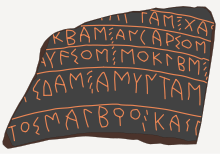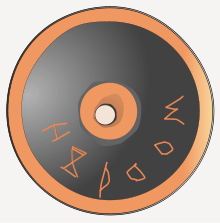San (letter)
San (Ϻ) was an archaic letter of the Greek alphabet. Its shape was similar to modern M, or to a modern Greek Sigma (Σ) turned sideways, and it was used as an alternative to Sigma to denote the sound /s/. Unlike Sigma, whose position in the alphabet is between Rho and Tau, San appeared between Pi and Qoppa in alphabetic order. In addition to denoting this separate archaic character, the name "San" was also used as an alternative name to denote the standard letter Sigma.
 | ||||||||||||||||||||||||||||||||||||||||||||||||
| Greek alphabet | ||||||||||||||||||||||||||||||||||||||||||||||||
|---|---|---|---|---|---|---|---|---|---|---|---|---|---|---|---|---|---|---|---|---|---|---|---|---|---|---|---|---|---|---|---|---|---|---|---|---|---|---|---|---|---|---|---|---|---|---|---|---|
|
||||||||||||||||||||||||||||||||||||||||||||||||
| History | ||||||||||||||||||||||||||||||||||||||||||||||||
| Use in other languages | ||||||||||||||||||||||||||||||||||||||||||||||||
| Related topics | ||||||||||||||||||||||||||||||||||||||||||||||||
| ||||||||||||||||||||||||||||||||||||||||||||||||

]........ΑΝΤΑΣ:ΧΑ.[
]....ΚΕΑΣ:ΑΝΓΑΡΙΟΣ[
]...ΑΥϜΙΟΣ:ΣΟΚΛΕΣ:[
].ΤΙΔΑΣ:ΑΜΥΝΤΑΣ[
]ΤΟΙ ΜΑΛΕϘΟ:ΚΑΙ.[

Historical use
Sigma and san
The existence of the two competing letters Sigma and San is traditionally believed to have been due to confusion during the adoption of the Greek alphabet from the Phoenician script, because Phoenician had more sibilant (s-like) sounds than Greek had. According to one theory,[1]:25–27 the distribution of the sibilant letters in Greek is due to pair-wise confusion between the sounds and alphabet positions of the four Phoenician sibilant signs: Greek Sigma got its shape and alphabetic position from Phoenician Šin (![]()
![]()
![]()
![]()
According to a different theory,[2] "San" was indeed the original name of what is now known as Sigma, and as such presents a direct representation of the corresponding name "Shin" in that position. This name was only later also associated with the alternative local letter now known as "San", whose original name remains unknown. The modern name "Sigma", in turn, was a transparent Greek innovation that simply meant "hissing", based on a nominalization of a verb σίζω (sízō, from an earlier stem *sigj-, meaning 'to hiss').
Moreover, a modern re-interpretation of the sound values of the sibilants in Proto-Semitic, and thus in Phoenician, can account for the values of the Greek sibilants with less recourse to "confusion". Most significant is the reconstruction of Šin as [s] and thus also the source of the sound value of Sigma; in turn, Samekh is reconstructed as the affricate [ts], which is a better match for the plosive-fricative cluster value [kʰs] of Xi.[3]
| Phoenician | Greek | ||||||||
|---|---|---|---|---|---|---|---|---|---|
| shape | position | name | traditional sound |
sound after Kogan[3] |
shape | position | name | sound | |
| after R | Shin | /ʃ/ | /s/ | Σ | after R | Sigma | /s/ | ||
| after N | Samekh | /s/ | /ts/ | Ξ | after N | Xi | /ks/ | ||
| after W | Zayin | /z/ | /dz/ | Ζ | after W | Zeta | /dz/,/zd/ | ||
| after P | Tsade | /ts/ | /tsʼ/ | Ϻ | after P | San | */z/? > /s/ | ||
Whereas in early abecedaria, Sigma and San are typically listed as two separate letters in their separate alphabetic positions, each Greek dialect tended to use either San or Sigma exclusively in practical writing. The use of San became a characteristic of the Doric dialects of Corinth and neighboring Sikyon, as well as Crete. San became largely obsolete by the second half of the fifth century BC, when it was generally replaced by Sigma, although in Crete it continued in use for about a century longer. In Sikyon, it was retained as a symbolic mark of the city used on coin inscriptions (just as the likewise archaic Qoppa was used by Corinth, and a special local form of Beta by Byzantium).
San could be written with the outer stems either straight (![]()
![]()
![]()
![]()
![]()
![]()
Outside Greece, San was borrowed into the Old Italic alphabets (𐌑, transcribed as Ś). It initially retained its M-shape in the archaic Etruscan alphabet, but from the 6th century BC changing its aspect to a shape similar to that of the d-rune ![]()
The name of "San" lived on as an alternative (dialectal or archaic) name for "Sigma" even at a time when the letter itself had everywhere been replaced with standard Sigma. Thus, Herodotus in the late 5th century reports that the same letter was called "San" by the Dorians but "Sigma" by the Ionians.[4] Athenaeus in his Deipnosophistae (c.200 AD) quotes an epigram which contained the spelled-out name of the philosopher Thrasymachus, still using "San" as the name for Sigma:[5]
τοὔνομα θῆτα ῥῶ ἄλφα σὰν ὖ μῦ ἄλφα χεῖ οὖ σάν,
πατρὶς Χαλκηδών· ἡ δὲ τέχνη σοφίη.
"Name: Θ-Ρ-Α-Σ-Υ-Μ-Α-Χ-Ο-Σ,
Birthplace: Chalcedon; profession: wisdom"
Arcadian "tsan"

A unique letter variant, shaped ![]()
- иις (cf. Attic τις, 'somebody')
- иινα (cf. Attic τινα, 'somebody')
- οиεοι (cf. Attic ὅτῳ 'to whomever')
- ειиε (cf. Attic εἴτε 'either')
From these correspondences, it can be concluded that the letter most likely denoted an affricate sound, possibly [ts] or [tʃ], which would have been a natural intermediate step in the sound change from */kʷ/ to /s/.[6] The letter has been represented in modern scholarly transcriptions of the Mantinea inscription by ⟨ś⟩ (s with an acute accent) or by ⟨σ̱⟩ (sigma with a macron underneath).[7]
Note, however, that the same symbol is used to denote the unrelated letter waw (/w/) in Pamphylia (the "Pamphylian digamma") and ![]()
Sampi
The Ionian letter ![]()
Bactrian þ

In the Greek script used for writing the Bactrian language, there existed a letter resembling a "þ", which apparently stood for the sound /ʃ/ (transliterated as š) and has been named "Sho" in recent times. According to one hypothesis, this letter too may go back to San.[9]
Modern use
.png)
In modern editions and transcriptions of ancient Greek writing, San has rarely been used as a separate letter. Since it never contrasts systematically with Sigma except in abecedaria, it is usually silently regularized to Sigma in modern editorial practice.[10] In the electronic encoding standard Unicode, a pair of uppercase and lowercase forms of the letter was introduced in version 4.0 (2003).[11] For this purpose, new lowercase forms for modern typography, for which no prior typographic tradition existed, had to be designed.[12] Most fonts have adopted the convention of distinguishing uppercase San from Mu by having its central V-like section descend only halfway down above the baseline, and lowercase San by giving it a left stem descending below the baseline. (Note that in historical epigraphic practice it was the other way round, with San being symmetrical and Mu having a longer left stem.)
Character encoding
San is encoded in Unicode, while the Arcadian "Tsan" variant is unified with the identical-looking Pamphylian Digamma since version 5.1.[13]
| Preview | Ϻ | ϻ | Ͷ | ͷ | ||||
|---|---|---|---|---|---|---|---|---|
| Unicode name | GREEK CAPITAL LETTER SAN | GREEK SMALL LETTER SAN | GREEK CAPITAL LETTER PAMPHYLIAN DIGAMMA | GREEK SMALL LETTER PAMPHYLIAN DIGAMMA | ||||
| Encodings | decimal | hex | decimal | hex | decimal | hex | decimal | hex |
| Unicode | 1018 | U+03FA | 1019 | U+03FB | 886 | U+0376 | 887 | U+0377 |
| UTF-8 | 207 186 | CF BA | 207 187 | CF BB | 205 182 | CD B6 | 205 183 | CD B7 |
| Numeric character reference | Ϻ | Ϻ | ϻ | ϻ | Ͷ | Ͷ | ͷ | ͷ |
References
- Jeffery, Lilian H. (1961). The local scripts of archaic Greece. Oxford: Clarendon.
- Woodard, Roger D. (2006). "Alphabet". In Wilson, Nigel Guy (ed.). Encyclopedia of ancient Greece. London: Routldedge. p. 38.
- Kogan, Leonid (2011). "Proto-Semitic Phonetics and Phonology". In Semitic languages: an international handbook, Stefan Weninger, ed. Berlin: Walter de Gruyter. p. 69.
- "…τὠυτὸ γράμμα, τὸ Δωριέες μὲν σὰν καλέουσι ,Ἴωνες δὲ σίγμα" ('…the same letter, which the Dorians call "San", but the Ionians "Sigma"…'; Herodotus, Histories 1.139); cf. Nick Nicholas, Non-Attic letters Archived 2012-06-28 at Archive.today.
- Athenaeus, Deipnosophistae, 10.81.
- Woodard, Roger D. (1997). Greek writing from Knossos to Homer: a linguistic interpretation of the origin of the Greek alphabet and the continuity of ancient Greek literacy. Oxford: Oxford University Press. pp. 177–179.
- Nicholas, Nick (2005). "Proposal to add Greek epigraphical letters to the UCS" (PDF). Archived from the original (PDF) on 2006-05-05. Retrieved 2010-08-12.
- "PHI Greek Inscriptions: IB V,2 262". Retrieved 2010-08-12.
- Tarn, William Woodthorpe (1961). The Greeks in Bactria and India. Cambridge: Cambridge University Press. p. 508. ISBN 9781108009416.
- Nick Nicholas, Non-Attic letters Archived 2012-06-28 at Archive.today
- Unicode character database
- David Perry (2002) Design of the Greek archaic letter San for use in computer fonts Archived 2010-09-29 at the Wayback Machine
- "The Unicode Standard, Version 5.1: Greek and Coptic, Range 0370–03FF" (PDF). Retrieved 2010-08-12.